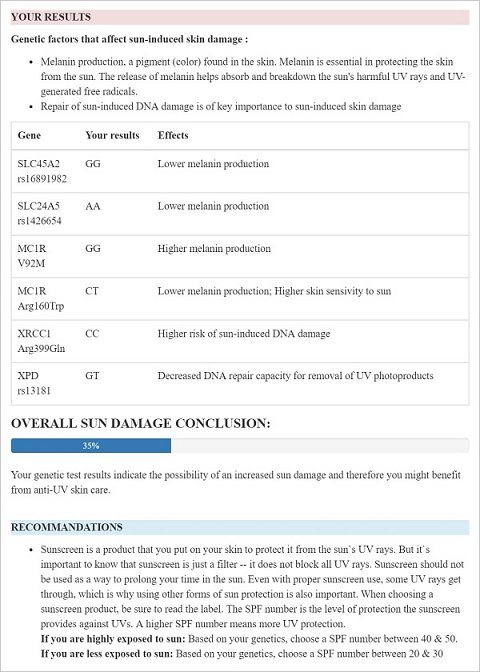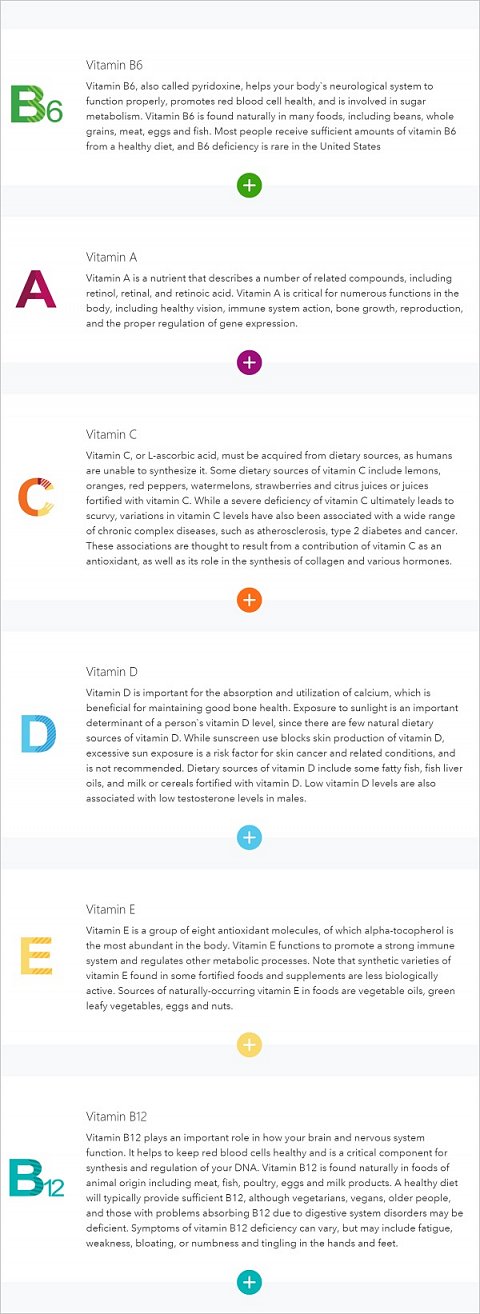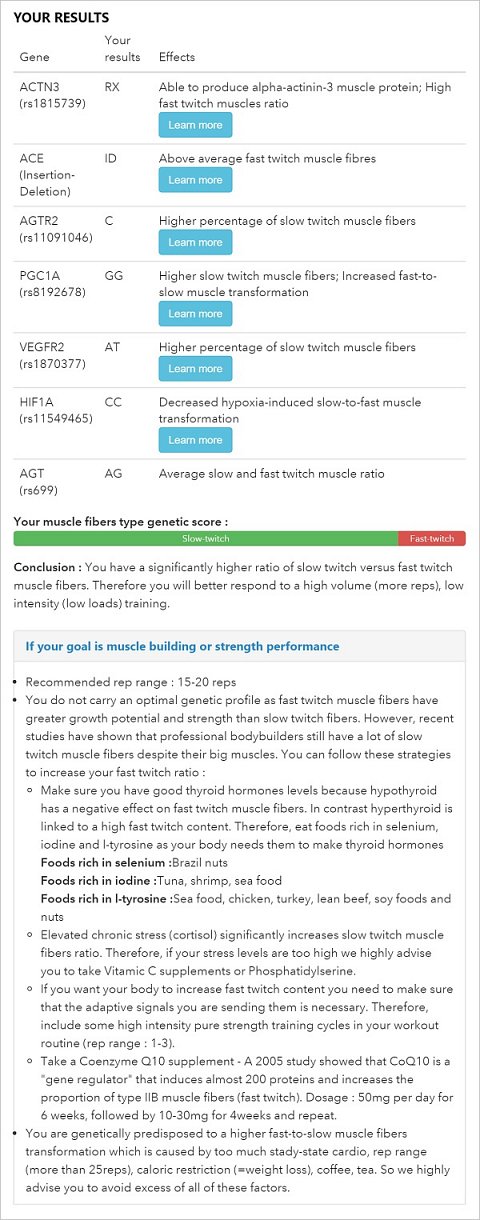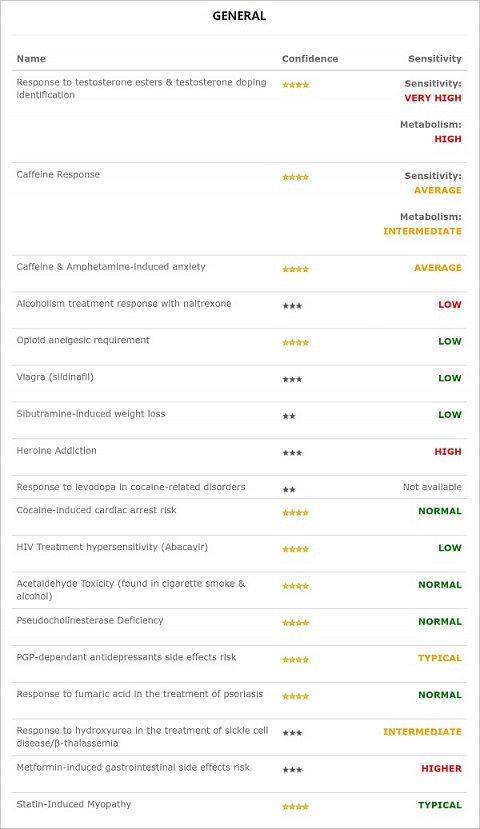-
All-in One DNA Test
review on 7 June 2016
by Craig Macpherson

At a Glance
Summary
To conclude, the ‘All-in one DNA Test’ from GenetiConcept is excellent. It interprets more genetic associations than any other test on the market today, and every single interpretation is easy to understand and responsibly discussed.
One aspect that really stands out is that just the right amount of information is provided and at just the right level.
It’s a shame that the scientific references for each association weren’t provided as there were several results that I would have liked to research further. I also found that some pieces of advice conflicted with others i.e. the training reports said that I should both train less and more frequently than average.
There’s no doubt that this test provides greater value for money than any other currently available, even though it doesn’t deliver every result specified on their website. I’d recommend this test to anyone interested in their health, training regimen, nutrition, skincare or sensitivity to drugs.
Full Review
GenetiConcept was launched last year by the same company who launched AnabolicGenes in 2014. GenetiConcept focusses on a wider range of genetic predispositions than AnabolicGenes (which focusses on health and fitness). We were impressed by the sheer number of analyses undertaken by GenetiConcept and jumped at the chance to try the test.
Product Expectations
GenetiConcept offer one ‘All-in one DNA Test’. They sell a ‘Fitness DNA Test’ too but this is conducted by AnabolicGenes, another company in the same group. The site said that the ‘All-in one DNA Test’ would give me: Genetic risk and non-medical prevention strategies for over 100 diseases, the genetic effect of over 120 medications, a skin beauty analysis that would identify my optimal skincare products, a genetically tailored training and nutrition plan tailored to my goals, and the right ingredients for optimal brain function and stress reduction.
I read that over 100,000 markers would be analysed, that only preventable and treatable conditions would be covered, and that the report was not intended to diagnose, cure or treat any disease. Bearing this in mind, I was surprised to see Alzheimer’s in the list of health conditions tested for, as I didn’t think that this was preventable or treatable.
There was lots of information covering each of the five types of analysis that was easy to navigate and understand. The ordering page informed me that the results came with an uninterpreted raw data file containing the markers tested (over a million), and that my results would be continually updated as new research was produced.
The ordering page also said that by buying the test I’d be able to “dramatically increase my health, fitness, skin and wellness”. I’d not seen a genetic testing company make such a strong claim before and I couldn’t wait to find out what GenetiConcept was doing differently!
A link to the terms and conditions for the test was provided at the bottom of GenetiConcept’s site pages. This was incredibly hard to read as it consisted of five blocks of text which weren’t separated into paragraphs or bullet points. I was interested to note that the terms advised that I “talk to a genetic counsellor prior to collecting the sample for testing, so that you can make an informed decision about whether testing is right for you.” I was also surprised to note that no information was provided about what would happen to my sample after it was tested.
Ordering Process
The ordering process was straightforward but I was disappointed to learn that I’d have to join ‘Payza’, a payment platform (like PayPal) that I’d not heard of before. I wish there’d been a way to pay without creating a Payza account.
A few days later I received the testing kit in an attractive branded box. The instructions were easy to follow and it was simple to collect a saliva sample. A one-page consent form was also included and it gave me the opportunity to participate in GenetiConcept’s research program (which I declined).
I dispatched my sample back to GenetiConcept’s lab in Paris, it was a shame that I had to go to the post office for this and pay a postage fee. A few days later I received an email to say my sample had been received and that my results would be ready in 6-8 weeks.
Results
Six weeks later I was emailed login details for an online account so that I could view my results. My results were divided into six sections: ‘5 Skin reports’, ‘6 Wellness reports’, ’18 Nutrition reports’, ’16 Training reports’, ‘167 Health reports’ and ‘141 Drug reports’.
Results Section: 5 Skin reports
This section was divided into five sub-sections: ‘Firmness & Elasticity’, ‘Inflammation’, ‘Glycation’, ‘Free radical damage’ and ‘Sun damage & Pigmentation’. Each sub-section described the science behind the genetic variations sought and their effects, my results were provided and recommendations were outlined.
For Firmness & Elasticity, I learned that I possess a variant of the MMP1 gene that means I experience the mid-level collagen breakdown rate, and that my skin ages at the average rate. I learned that smoking and excessive exposure to sunlight would cause my collagen breakdown rate to increase, and that I could add cream for collagen support into my cosmetic routine. I also read that white or green tea extract could strengthen collagen, and that grape seed extract could stabilise my collagen.
Looking at the other sub-sections, the Inflammation section showed that have increased inflammation and skin sensitivity, and that I should incorporate ingredients into my skin products that protect against skin sensitivity and inflammation. The Glycation section showed that I have an average glycation risk and so I should include anti-glycation skincare into my regimen, depending on a number of lifestyle factors that GenetiConcept outlined (it looks like I would benefit because I eat a lot of sugary foods!). The Free radical damage section showed that I have a reduced capacity to neutralise free radicals, and that I would benefit from using anti-oxidant cream.
The Sun damage & Pigmentation section (shown below) showed that I have an increased risk of sun damage and might benefit from anti-UV skincare. A diagram was contained in this section showing that my ‘overall sun damage conclusion’ was 35%, but I wasn’t sure what this meant.

My Sun damage & Pigmentation result.
I was blown away by the information contained in these 5 skin reports. The science behind the genetic variants I possess and their effects was easy to understand, my results were clear and the recommendations were comprehensive.
Results Section: 6 Wellness reports
When I entered this section a message was displayed that said “Section under construction. You'll receive an email once this section is available.” Beneath this, I could see a brain-like diagram with six labels: Glutamate, Adrenaline, Serotonin, Gaba, Acetyl-choline and Dopamine. I was disappointed that this section wasn’t ready but I was glad to know my account would be updated with the results at a later stage.
Results Section: 18 Nutrition reports
This section contained nine sub-sections: ‘Carbohydrates metabolism’, ‘Fat metabolism’, ‘Vitamins profile’, ‘Folate metabolism’, ‘Lactose intolerance’, ‘Gluten intolerance’, ‘Testosterone optimisation system’, ‘Caffeine sensitivity’ and ‘Hunger and appetite control’.
Each sub-section contained a number of reports. Each report contained a summary explaining why it was important, my results were outlined, and recommendations were provided.
For Carbohydrates metabolism, I learned that I have below average insulin resistance and it was recommended that carbohydrates make up 50% of my diet. I learned that I’m less likely to increase my insulin sensitivity through exercise. I also read that I have an increased capacity to use glycogen as an energy source during training, and that I should include a high proportion of carbohydrates in my post-workout meals and snacks.
For Fat metabolism, I read that I’m less sensitive to saturated fats, that monounsaturated fats are likely to affect my bodyweight (so no more than 15% of my calories should come from monounsaturated fats), and that I have a decreased risk of having high triglyceride levels in my bloodstream (which is a good thing apparently!).
For my Vitamins profile (summary page shown below), GenetiConcept showed that I’m likely to suffer lower levels of Vitamin B6, higher levels of Vitamin A, lower levels of Vitamin C, lower levels of Vitamin D, lower levels of Vitamin E and higher levels of Vitamin B12.

My Personal Vitamin needs summary.
For Folate metabolism, I read that I’m likely to have an inefficient folate metabolism and that I should eat foods rich in folate. For Lactose intolerance I read that I’m lactose tolerant (which is true!), and for Gluten intolerance I read that I have a lower risk of gluten intolerance (I don’t suffer with gluten intolerance). For Testosterone optimisation system, I read that I have a very high testosterone level and that testosterone boosters (used to help you work out) would have a minimal effect. For Caffeine sensitivity I read that I’m a mid-level metaboliser, susceptible to increased anxiety from caffeine consumption but I have a decreased risk of caffeine-induced sleep impairment.
For Hunger and appetite control, I read that I’m predisposed to having a very high appetite (which is true!) and that I have a high obesity risk. The report said that I was ‘biologically programmed to eat more’, that I should make sure I exercise regularly, that high-intensity exercise would help suppress my appetite after working out, and that high-fat/low-carb diets are less likely to work for me. This information wasn’t worrying for me as I’m currently at the lower end of my recommended BMI.
Just like the 5 skin reports, the information contained in these 18 nutrition reports was fantastic. The science behind the genetic variants I possess and their effects was easy to understand, my results were clear and the recommendations were comprehensive.
Results Section: 16 Training reports
This section contained eight sub-sections: ‘Strength vs. endurance’, ‘Recovery and training frequency’, ‘Testosterone response to training’, ‘Lactate threshold’, ‘Hypoxic training response’, ‘Muscle hypertrophy’, ‘Steady state cardio vs. HIIT training’ and ‘Injury prevention’.
Each sub-section contained a number of reports. Each report contained a summary explaining why it was important, my results were outlined, and recommendations were provided.
For my Strength vs. endurance profile I learned that for my muscle fibre type composition (shown below), I have a higher ratio of slow twitch vs. fast twitch muscle and I’ll respond better to high volume, low intensity training. There was an opportunity in this section to say whether my goal is muscle building/strength performance or endurance performance. I selected ‘muscle building/strength performance’ and this revealed additional advice (included in the screenshot below).

My muscle type fibre composition.
I also learned that I’m predisposed to an intermediate VO2 max, an above average endurance capacity, but a low strength capacity.
For my Recovery and training frequency result, I read that I have a low recovery ability and would benefit from nutritional support and a lower than average training frequency. For my Testosterone response to training, GenetiConcept said that my increased testosterone levels mean that my body builds and repairs my muscles more frequently, and so I can train more frequently and at greater intensity than the average person.
For my Lactate threshold, I read that I’m predisposed to high improvements in lactate threshold through training which means I have high trainability. When appropriately trained, I read that I should be able to exercise harder, faster and longer than average before experiencing intense fatigue.
For Hypoxic training response, I read that I exhibit low ‘slow to fast’ fibre transformation in response to hypoxic training, that hypoxic training wouldn’t help me build muscle, but it would help me increase my VO2 max. For Muscle hypertrophy, I read that I’m predisposed to reduced muscle damage during training, but that I have a decreased hypertrophic response to muscle damage (leading to a less efficient muscle repair process). I also read that I have an average hypertrophy response to hypertension.
For Steady state cardio vs. HIIT (high intensity interval training), I learned that I have a decreased response to steady state cardio, and that steady state cardio would be less effective for helping me to lose weight if I wished to do so. I also read that I’d respond well to HIIT and that 2-3 HIIT sessions per week were recommended for me.
For Injury prevention I read that I’m less vulnerable to tendon injury, I have an average vulnerability to ligament injury, and I’m less vulnerable to lumbar disc degeneration. Great news to me!
I felt this whole section was incredibly powerful, and that if I was more serious about reaching certain fitness goals, this information would be invaluable.
Results Section: 167 Health reports
This section contained two sub-sections: ‘Hereditary disease’ and ‘Health risks’. For Hereditary disease, I read that the conditions were categorised by those I have no risk for, those I may only ‘carry’ (and thus potentially pass to my children) and those I may suffer with. 47 conditions were listed including Bloom’s Syndrome, Caravan Disease, Cystic Fibrosis, Gaucher Disease, Sickle Cell Anaemia and Tay-Sachs Disease.
Each condition linked to a page that explained what it was, the typical signs and symptoms, the genetic variations sought and their effects, the treatments, my results, and advice for what I can do if I suffer with the condition.
I was relieved to see that I only had one risk (of either carrying or suffering with) Alpha-1 Antitrypsin Deficiency. My results and the advice for what I can do if I suffer with the condition are shown below:

My Alpha-1 antitrypsin deficiency result and what I can do if I have the condition.
I was alarmed by this result and made a note to bring it up when I next saw my doctor. I don’t smoke and so I’m not worried by the potential for decreased lung function, but an increased risk of liver disease is a concern. I noticed the recommendations included vaccinations against Hepatitis A and B which thankfully I’ve already had.
For the Health risks sub-section, although over 100 risks were listed, they were all marked as ‘soon available’ which was disappointing.
Results Section: 141 Drug reports
This section divided the 141 reports into: ‘General’ (shown below), ‘Neuropsychiatric – pain management’, ‘Antipsychotic’, ‘Cardiovascular – antiarrhythmic’, ‘Immunological’, ‘Neuropsychiatric – antidepressant’, ‘Neuropsychiatric – anxiolytic’, ‘Steroids’, ‘Pain management’, ‘Neuropsychiatric – pro-cognitive’, ‘Cardiovascular – cholesterol lowering’, ‘Cardiovascular – antihypertensive’, ‘Anti-infectives’, ‘Cardiovascular – anticoagulant’ and ‘Oncology’.

My response to ‘General’ drugs.
Each drug report described the science behind the genetic variations sought and their effects, my results and a conclusion.
As I’m a pretty healthy person who isn’t currently taking any medication, the vast majority of these results didn’t mean that much to me. However, it was interesting to go through my general risks, to see that I’m predisposed to a low sensitivity to Viagra and that I have a high risk of heroin addiction!
Summary
To conclude, the ‘All-in one DNA Test’ from GenetiConcept is excellent. It interprets more genetic associations than any other test on the market today, and every single interpretation is easy to understand and responsibly discussed.
One aspect that really stands out is that just the right amount of information is provided and at just the right level.
It’s a shame that the scientific references for each association weren’t provided as there were several results that I would have liked to research further. I also found that some pieces of advice conflicted with others i.e. the training reports said that I should both train less and more frequently than average.
There’s no doubt that this test provides greater value for money than any other currently available, even though it doesn’t deliver every result specified on their website. I’d recommend this test to anyone interested in their health, training regimen, nutrition, skincare or sensitivity to drugs.
Please note that we were invited to take this test free of charge.
GenetiConcept's Response
We’d like to add that our customer service is one of our biggest strengths and really appreciated by our customers. We promise to reply to each of our emails in 24hours, but most often we reply within 4-6 hours.
Concerning references citation, we are planning to add it very soon.
We have also just signed a contract with a new payment processor and will replace Payza within 24-48hours. So there will be no need to register with Payza. The payment will be very easy via credit card.
Please note that this test may have changed since our review was written. To ensure you know what to expect from this test, please check the company's website.

